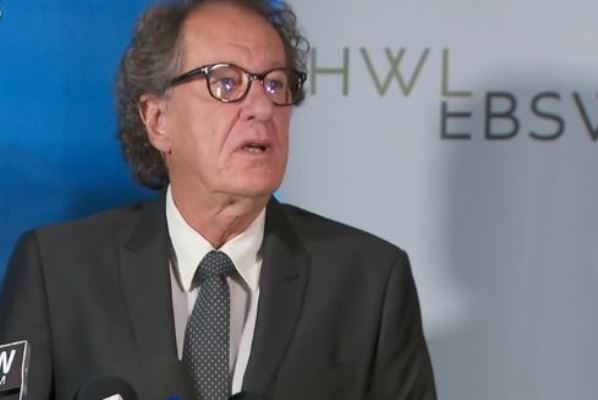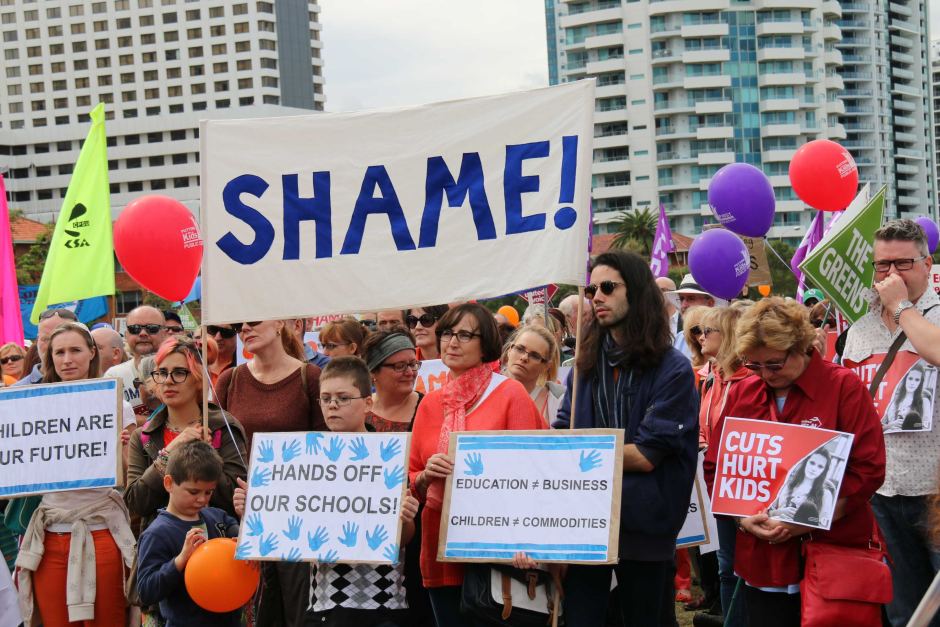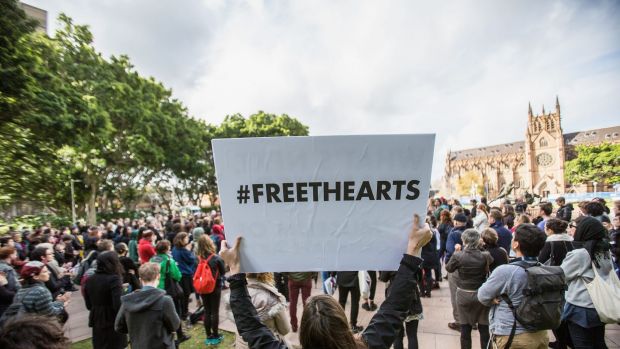By Judith White
It’s been a difficult year for many public institutions in Australia, but as it draws to a close we can take heart from the growing numbers of people ready to speak out against the governmental idiocy responsible.
When writer and former Wallaby Peter FitzSimons launched a petition a couple of weeks ago against NSW Premier Gladys Berejiklian’s decision to spend $2.3 billion rebuilding Sydney sports stadiums, he was amazed by the response – 150,000 signatures and counting.
“We are tired,” the petition reads in part, “of taxpayer dollars being lavished on building facilities for Sports Big Business, while community sport withers on the vine for lack of facilities and resources.”
The same holds true in the arts, where vanity projects pursued by corporate interests simply reinforce the underfunding of cultural facilities for the majority of the population.

Early design concept for Sydney Modern, with harbour views
A case in point is the controversial $344 million Sydney Modern expansion at the Art Gallery of New South Wales (AGNSW). A large number of people – many of them distinguished in the arts and public service – have submitted unimpeachable documents opposing the project’s Development Application (DA) for the project. They include a highly professional objection lodged by members of the group that includes architect David Chesterman, horticulturist Ros Andrews, arts and gardens expert Gillian Appleton and lawyer, heritage and environmental law specialist Bruce Donald. If you have been following this blog, you’re already familiar with my arguments against the project, which are summarised in recent posts here. Submissions closed on Friday 15 December.
Board responsibilities
The lodging of the DA for Sydney Modern has been accompanied by a relentless media campaign from the AGNSW, most recently trumpeting the $88 million in pledges from private donors to supplement the $244 million promised by the State government in June.
Circulating in Sydney art world circles is an email director Michael Brand recently sent to all Gallery staff about the capital campaign. Entitled “Packer Family Gallery” and dated 5 December, it reads in part:
“Another great week for the Gallery with the announcement that major pledges to the Sydney Modern Project capital campaign have now brought the total [sic] $88 million.
“As you know this unprecedented philanthropic support for our expansion is led by Susan and Isaac Wakil with their extraordinary gift of $20 million announced in June.
“During the year the Gallery received further remarkable philanthropic gifts for our expansion including five gifts of $5 million or more, as well as early commitments of $1 million or more from a further 20 private donors.
“The five gifts of $5 million or more, pledged to support galleries in the new building are from the following major donors:
- The Ainsworth family, whose pledge comprises gifts made by AGNSW Trustee Geoff Ainsworth and Jo Featherstone, Len Ainsworth, Mark Ainsworth, and Paul and Valeria Ainsworth
- The Lowy family, including former Board presidents Sir Frank Lowy AC and Steven Lowy AM
- Kerr Neilson, a well-known supporter of the arts and culture in Sydney
- Mark Nelson, Board vice-president and chair of the campaign committee, with his wife Louise Nelson
- Gretel Packer, AGNSW Trustee and campaign committee member, also a key supporter of Learning and Participation programs at the Gallery
“It’s an incredible honour that the Gallery has received such strong support from the Ainsworth and Lowy families, Kerr Neilson, the Nelsons and Gretel Packer and I thank them for their ongoing support.
“Speaking of ongoing support, Gretel is in fact the third generation of the Packer family to support AGNSW – the family’s philanthropic contribution dating back to 1953 (see below).
“In recognition of this long-standing support, it’s my great pleasure to let you know that from today onwards our major exhibition gallery, where our Rembrandt exhibition is currently on display, will be known as the Packer Family Gallery.”
Staff were said to be choking on their lattes when Dr Brand’s missive came over the airwaves. An “incredible honour” that the multibillionaire Lowy family is contributing “$5 million or more”? That’s small change for the Lowys, whose patriarch Frank, recently knighted by the Queen of England, is fourth on the BRW Rich List with a personal fortune of $8.26 billion. The family have recently accepted a takeover bid of $32.8 billion for their overseas Westfield holdings. Even if they stumped up the extra $12 million needed to complete the Sydney Modern capital campaign target, it would still be small change to them.

Bryan Westwood ‘Portrait of Frank Lowy’ 1997
This is a family that has dominated the board of trustees at the AGNSW for 28 years, with the presidency held successively by Frank Lowy, close associate and adviser David Gonski, Steven Lowy, then briefly Guido Belgiorno-Nettis of Transfield, and, since 2016, David Gonski again. When Frank Lowy completed his tenure in 1996, on being reminded that it was considered good form for a wealthy board member to make some contribution, he donated a portrait of himself by Bryan Westwood which has remained in storage ever since.
His son Steven Lowy (currently embroiled in a fight with world soccer’s ruling body FIFA over governance of the game in Australia) was president of the AGNSW board in 2013 when the Sydney Modern plan was announced, blindsiding the NSW government. There was much criticism at the time that the Lowys, who had just sold a stake in the Westfield Retail Trust for $663.7 million, were making no financial commitment themselves. Instead, lobbying of government began in earnest, but it took more than four years before Premier Gladys Berejiklian and her Arts Minister Don Harwin succumbed.
During that time, staff saw talented colleagues made redundant and core functions outsourced, while a super-executive was created of nine people, each paid more than $200,000, with pursuit of the Sydney Modern plan as their main objective.
The result has been a decline in the kind of original work on which a public institution’s reputation depends. Even this summer’s main exhibition Rembrandt and the Dutch Golden Age, which contains undoubted masterpieces by Rembrandt, Vermeer and Frans Hals, is largely recycled with the same exhibits shown by the National Gallery of Victoria 12 years ago. Critic John McDonald, while acknowledging the quality of some of the works, was so appalled by the lack of curatorial effort that he wrote: “If the AGNSW imagines a proposed extension means it is about ‘to join [the] world’s greatest art museums’, it must start to act like a museum not like a shop-front for hire.” That’s not a description a board should be proud of.

Geoffrey Rush announcing lawsuit against Daily Telegraph
Talking of boards: Gretel Packer, so effusively thanked by Dr Brand in his email, is also on the board of the Sydney Theatre Company (STC). Who at the STC is going to take responsibility for the appalling mistreatment of actor Geoffrey Rush? You can’t take a workplace complaint against someone, fail to tell the accused about it, and then two years later broadcast its existence with a press release. We still don’t know who the accuser was, or what the allegations were. Rush is suing Rupert Murdoch’s Daily Telegraph for its reporting of the matter, and I hope he wins. But the board has to take responsibility for governance at the STC. Where are they?
Battle lines drawn
As 2018 approaches there is no sign of a let-up in the assault on cultural institutions in Australia. Federal and State governments continue to slash recurrent funding for the arts and sciences, while occasionally throwing money at vanity building projects at the request of their big business mates.
Universities face another year of number-crunching, with courses in the humanities downgraded and scientific research projects subjected to commercial outcomes.
At the ABC, Michelle Guthrie’s team of super-executives seems hell-bent on dismantling Classic FM as we know it, axeing Lateline and hobbling serious reporting and critical commentary.
And now, at the end of the school year, comes a two-pronged attack on public education. On the one hand it’s revealed that Gonski Mark 2 gives massive benefits to private schools – 80 per cent of standard requirements, compared to 20 per cent for public schools. On the other hand, the federal government is using the results of the infamous American-inspired NAPLAN testing scheme to attack teachers for perceived poor outcomes.
Education Minister Simon Birmingham blames public schools for low results in Civics. He should look in the mirror. The performance of most of Australia’s politicians is enough to turn any thinking child away from the whole subject.

Protest at cuts to school funding
Public education is on the front line in the war on culture. From the 1970s onwards this country has punched above its weight in the arts and sciences, because of its investment in education – especially by the Whitlam Government (1972-75), which made tertiary education free.
What happens to education funding now is crucial. A healthy society requires that every child, from whatever social background, should have the opportunity to pick up a musical instrument, perform science experiments, explore the natural environment, see great art, read great books and develop sporting skills. And then go on, if they wish, to the tertiary education they deserve.
The only way to secure the future of civil society is for public funding to go to public schools. Any other course stokes up explosive social problems of dystopic proportions.
You can see the results already in the United States. Decades of economic rationalism, welfare cuts, free rein to the financial sector and the dumbing down of education – the hallmarks of Reaganomics and neoliberalism – have deepened social division in catastrophic ways. The presidency of Donald Trump may be the ultimate expression of these trends, but they’ve been going on for a long time under Democratic administrations too.
And Australian governments of both major parties have followed suit – introducing “metrics” for everything, buying in American programs like NAPLAN, and outsourcing core functions, often to American-owned multinationals. Even Before and After School Care is now at the mercy of the marketplace.
Enough!






That’s a wonderful analysis, Judith. The vandals are abroad and they are tearing at many of our important cultural institutions.And I’m glad you mentioned the outrageous treatment of Geoffrey Rush. The STC has a lot of explaining to do after it emerges from the shroud of cowardice behind which it is currently hiding